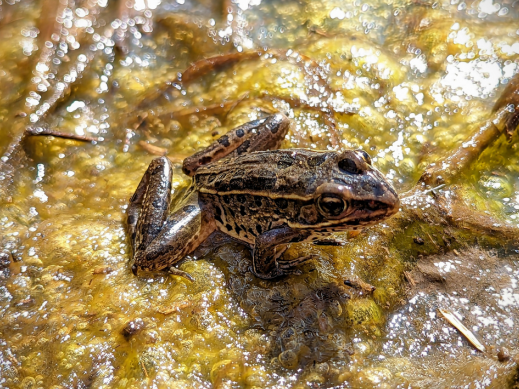By A. Berardi (8/23)

Quick Facts
- Northern leopard frog populations have been declining for several decades, and are listed as a Tier 1 Species of Greatest Conservation Need in Colorado.
- Northern leopard frogs can live at elevations as high as 11,000 feet.
- Common habitat for northern leopard frogs includes the banks and shallows of lakes, reservoirs, ponds, streams, irrigation ditches, beaver ponds, and marshes.
- Breeding occurs in the spring in shallow water, where frogs attach their eggs to emergent vegetation.
Identification
Northern leopard frogs (Lithobates pipiens) are one of several species of frog native to Colorado. Adult northern leopard frogs are usually between 2.5-4.5 inches long, and are either green, brown, or tan in color. These frogs have large round or oval “leopard” spots along their back, sides, and legs. They also have two parallel lines that start behind each eye and run continuously down the length of the back. Their breeding call is a long rattling snore, immediately followed by a short series of stuttering croaks, grunts, or chuckles.
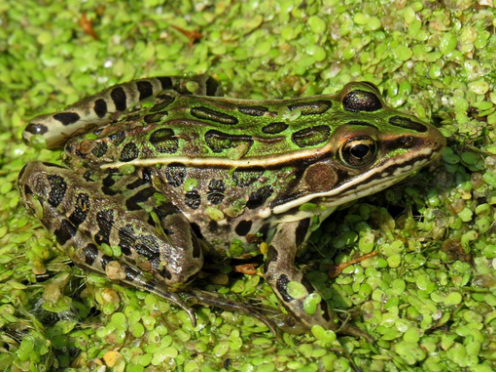
Distinguishing Features
Two other species of frog in Colorado are sometimes confused with northern leopard frogs: the plains leopard frog, and the American bullfrog.
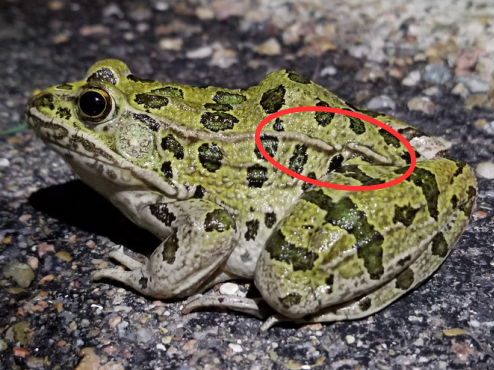
Plains leopard frogs are also native to Colorado, and are found in the southeastern part of the state. Unlike northern leopard frogs, the lines on their back are broken and inset near the rear of their back.
American bullfrogs are not native to Colorado, and are considered invasive. Unlike leopard frogs, bullfrogs do not have any large rounded spots or lines on their back. They are mostly green and brown, and often have spotting on their legs and bellies. Adult bullfrogs are generally much larger than adult leopard frogs, reaching over 6 inches long compared to 4.5 inches for a large leopard frog. When approached by a predator (or a human), bullfrogs will often make a short “Meep!” sound before jumping in the water.
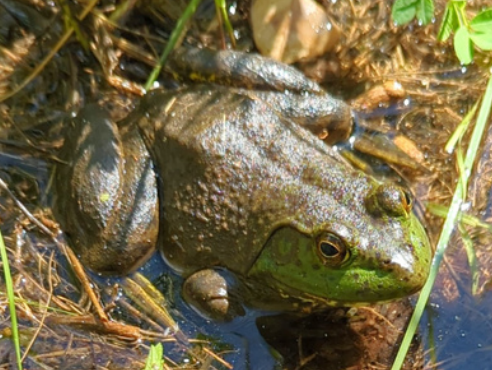
Range
Northern leopard frogs historically occurred throughout most of Colorado, and are absent from only five counties in the southeastern corner of the state. As with many amphibians, their populations tend to be highly localized, and Northern leopard frogs may be known from only a few locations in any given county. In Colorado, northern leopard frogs occur between 3,000 and 11,000 feet in elevation.
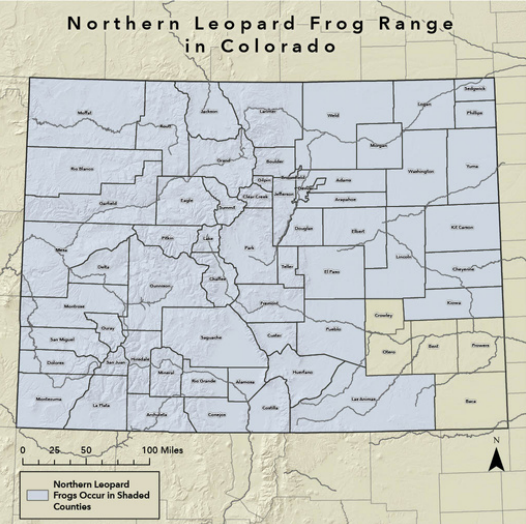
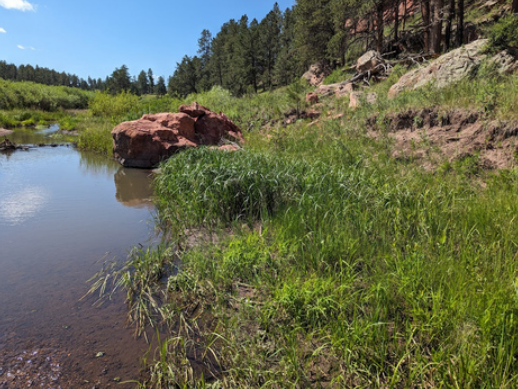
Habitat
Northern leopard frogs are usually found close to water. Common habitat for northern leopard frogs includes the banks and shallows of lakes, reservoirs, ponds, streams, irrigation ditches, beaver ponds, and marshes. Water bodies surrounded by grass, and with high sun exposure are ideal northern leopard frog habitat.
Diet and Behavior
Northern leopard frog tadpoles are mostly herbivores, eating plant material such as algae. Adult frogs eat mostly insects and other invertebrates, but they will occasionally eat vertebrates such as small snakes and other frogs.
When approached by a person, northern leopard frogs will hop towards the best cover, whether it is in the water or in surrounding vegetation. When they jump in the water, they will usually swim a short distance, and bury themselves in mud or plant matter.
Northern leopard frogs are also frequently found foraging in wet meadows, and can sometimes be found far from water during wet weather events.
During the winter, adult northern leopard frogs bury themselves at the bottom of water bodies, under mud or plant matter. The water must be deep enough that it does not freeze solid for frogs to survive the winter.
Breeding
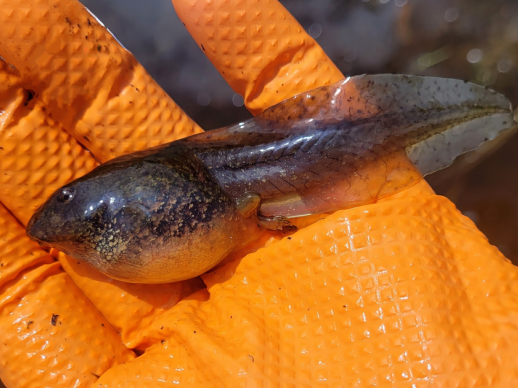
Breeding occurs in the spring in shallow water, where frogs attach their eggs to underwater vegetation. The vegetation also provides eggs and tadpoles with cover from predators such as fish, snakes, birds, salamanders, and bullfrogs. The eggs hatch into tadpoles, which can grow up to 4 inches long. As the summer progresses, the tadpoles begin to transform (i.e., metamorphose): they grow legs, lose their tail, and eventually become small frogs.
Conservation
Once abundant, northern leopard frogs have declined throughout much of their historical range. In Colorado, the decline has been most severe along the Front Range and the northeastern plains. Northern leopard frogs are currently listed as a Tier 1 Species of Greatest Conservation Need in Colorado, highlighting them as a top priority for conservation efforts in the state.
Factors that likely contributed to this decline include habitat loss/degradation, disease, pollution, drought, and the expansion of invasive predators such as bullfrogs.
Many of these factors are either directly or indirectly caused or intensified by human activity. Bullfrogs, for instance, require permanent bodies of water for their tadpoles to metamorphose into adults. The number of permanent water bodies has increased in Colorado due to human activities over the last several decades. This has allowed bullfrogs to encroach on northern leopard frog habitat to a greater degree than was previously possible. Bullfrogs grow larger, and may prey upon and out-compete northern leopard frogs for food.
Climate changes also negatively affect leopard frog populations. Increasingly frequent and prolonged drought reduces the amount of time that tadpoles have to grow and metamorphose in temporary wetlands, and sometimes eliminates breeding habitat altogether.
Understanding the relative contribution of habitat loss and alteration, invasive species, and climate change to northern leopard frog declines is the subject of current research by scientists in Colorado and elsewhere. Such information can inform the development of management actions to slow or halt the decline of this species in Colorado.
Resources
- Colorado Parks and Wildlife. (2015). State Wildlife Action Plan. Colorado Parks and Wildlife. https://cpw.state.co.us/aboutus/Pages/StateWildlifeActionPlan.aspx
- Colorado Parks and Wildlife. (2020, November). Assessing Habitat Quality for Priority Wildlife Species in Colorado Wetlands: Northern Leopard Frogs. https://cpw.state.co.us/Documents/LandWater/WetlandsProgram/PrioritySpecies/Factsheet-and-HabitatScorecard_LeopardFrogs.pdf
- Colorado Partners in Amphibian and Reptile Conservation. 2020. Northern Leopard Frog (Lithobates pipiens) Abbreviated Species Account. Compiled by Andrew M. DuBois. Revised by Rémi Pattyn. http://www.coparc.org/northern_leopard_frog. Accessed 29 July 2023.
- Hammerson, G. A. (1999). Amphibians and Reptiles in Colorado: A Colorado Field Guide. University Press of Colorado and Colorado Division of Wildlife.
- Smith, B. E., & Keinath, D. A. (2007, January 16). Northern Leopard Frog (Rana pipiens): A Technical Conservation Assessment. USDA Forest Service, Rocky Mountain Region.
Written by Anthony Berardi. (8/2023). Peer reviewed by Erin Muths (USGS) and Boyd Wright (CPW).


